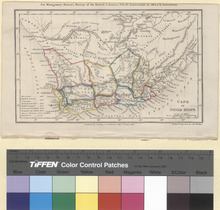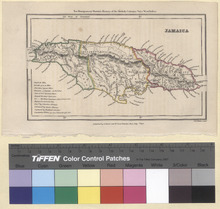Cape of Good Hope (1835)
Steel engraved 1834 map of The Cape of Good Hope from Montgomery Martin's History of the British Colonies Vol. 4 Possessions in Africa & Australasia. Cities appearing on the map: Cape: Capetown (Cape Town). Stellenbosch: Stellenbosch. Clanwilliam: Clanwilliam, Papkuils (?), Leeuwenkuil (?), Droeg Kr. (?), Schuit (?), and Lily Fn. (?). Swellendam: Caledon, Swellendam, and Zuurbrak (Suurbraak). Worcester: Worcester and Tulbagh. Beaufort: Beaufort (Beaufort West) and Karreebosoh (?). George: George Tn. (George) and Elandsrug. Uitenhage: Bethelsdorf (Bethelsdorp), Uitenhage, Hartebeest (?), and Enon. ?: Graaf Reynet (Graaff-Reinet). Albany: Graham Tn. (Grahamstown), Bathurst, and Fredericksburg (?). Somerset: Somerset T. (?) and Cradock. Namaqua-Land: Rhenoster F. (?), Africananders Kr. (?), Orlam Kr. (?), Konnah (?), Riizos Kr. (?), Hardcastle Kloof (?), Griqua or Klaarwater (?), Phillipolis Miss. Sn. (?), Letaka (?), Tureehee (?), Campeldorp (?), Bootschap (Boetsap), Kouna (?), Koning F. (?), Plattenburg (?), Moos (?), Mobatee (?), Hart Kr. (?), Litakou (?), Kruman or New Litakou (Kuruman), Maquassa (?), Gaikas Kr. (?), Khanvees Kr. (?), Tzatzoe (?), Vosanis Kr. (?), Matuana Kr. (?), Omjutas (?), and Mahaks Kr. (?). Written on the lower left corner of the map is the following information about the Cape of Good Hope: Discovered: 1487 English formal occupation: 1620 Dutch Colonization: 1650 British Conquest: 1795 Restoration to Dutch: 1803 Recapture by British: 1806 Area of Territory: 200,000 Sq. Miles Population: 150,000 Mapmakers: John Walker, Alexander Walker and Charles Walker, known collectively as J & C Walker (active 1820-95), were engravers, draughtsmen and publishers working through the 19th century.
Member of

